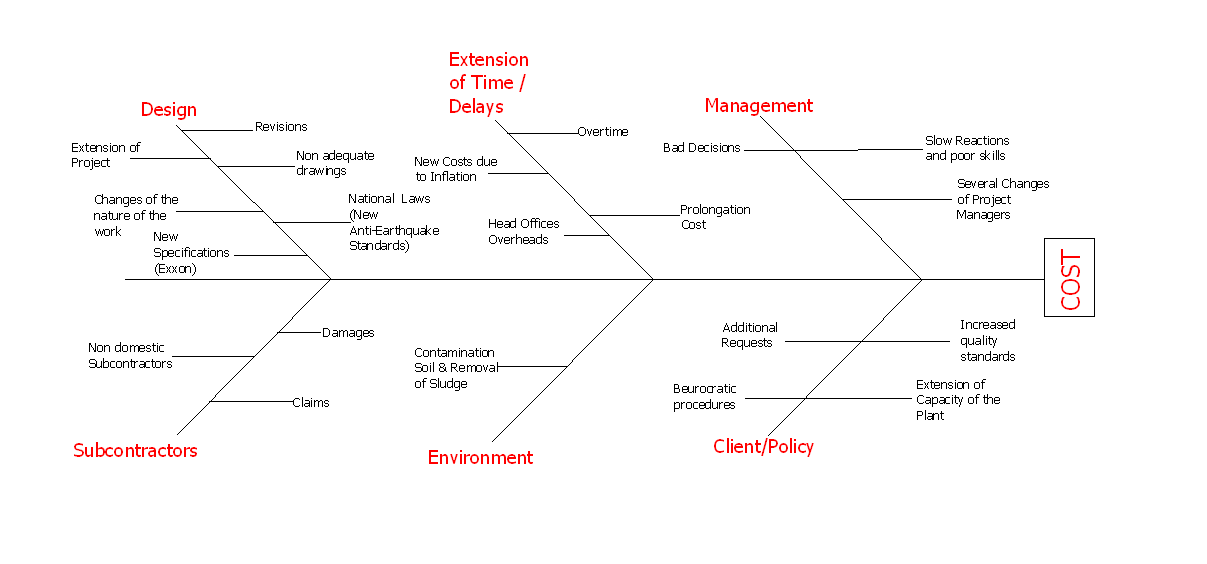College park univesity college press-maryland
Executive Summary
Project management refers to the task of managing and incorporating quality as well as total quality management principles and measures in all of the operations of a business or a firm in order to bring in better standards of goods and services that are provided to the customers. This report aims at preparing a construction plan and imbibes the required quality principles into it in order to frame a qualitative and standardized construction plan which enables a firm to imbibe control measures within the plan itself. This has been made possible with the use of a number of quality control tools and the usage of total quality management principles. The project analyzes a number of opportunities for change and improvement in terms of cost, time as well as deadlines which are the major concerns and considerations in a construction project. A number of operational research methods have been used like critical path analysis and identification of critical paths as well as the study of the WBS and functional units along with their analysis have been done. A number of problem solving techniques have been used. This includes fishbone diagrams and Pareto analysis as the main tools that have been used. In the end of the project we have added in a proposal for the purpose of improving the future projects or endeavors or operations that will be taken up. Construction projects are extremely complicated with a requirement of detailing, intricate, time- taking and also involving a lot of risk. It involves multiple phases and the whole of a project requires a lot of different varied skills and specialized services. All of this creates a lot of dependency on quality of every element of the business and service as that could impact and affect the overall project development as well as the final outcome or result.
A construction plan and design are very common and easy to make as technology develops. Yet there are a number of reasons which can cause delays in a project. There could be a number of causes for these delays. It is extremely important to resolve them and ensure that the project is carried out on time. The various causes for the possible delay have to be found and avoided. This should be done in a scientific manner. The impact of these delays is large. It causes disruption of all following activities and if it is a critical activity, it can lead to a complete halt of the project. All of these are essential to be considered before starting a construction project. The various reasons for the project delay should be known before hand in order to be able to adapt to contingency planning.
Delays are one of the biggest problems in construction business. In case of construction businesses delays can also increase the costs and cause the whole plan to fail in case of service providers not being ready to re schedule. Then it becomes extremely difficult to be able to reschedule and finish the project. So, it is extremely essential that a construction project is carried out on time. Construction projects could range from simple buildings to complex projects. Loss of productivity is a cause that causes delay in construction projects. All of these can be avoided using a number of scheduling and quality control tools.
After a year of negotiation, the Ower accepted the proposal, submitted by this large construction and engineering company, specialized in the making of petrochemical plants and refineries for the execution of the project for a price of 83.950.000 ECU plus 9.650.000.000 GRD.
The company invited a contractor to make the plan and submit the work as a subcontractor. This was for the proposal of execution of the major portion of the work. This was an extremely important a task and it is extremely important to note that they have to contribute to the services.
In this case these includes all kinds of earthworks, foundations, steel structures, industrial paving’s, erection of buildings, underground piping works and pits.
Mechanical Works
In this case these includes all installations of instruments, their connections and terminations, the laying of the instrument cables, the wiring in the control room, the installation of cabinets, consoles and the installation of all the control room etc…
Insulation Works
In this case this was included in the inspection of the existing pipeline system from the limits of the refinery up to its sea platform, all the required procurement of materials and equipment and final all the construction phase. The construction plan and phase included the fabrication and erection of one loading arm1 in a sea platform terminal - 800mt from the coast - and the interconnection with the project through a complex of valves and of one 10 inches pipeline of almost 5.500 m length, from which the 800mt are laid underwater and the rest 4.300mt are laid underground.
In general, all works of the disciplines are separated in the following stages:
Polymerization
Extrusion Area
Interconnecting Pipe racks (ISBL Area)
Interconnecting Pipe racks (OSBL Area)
Excavations
Concrete Foundations for the Steel Structures and construction of other buildings, like Electrical Substation, Control Room, Administration Buildings, Warehouses etc.
Fabrication and erection of pipe supports.
Erection of large bore piping.
Connections and terminations of cables.
Hydraulic and Pneumatic tests of piping and final reinstatement of all pipe lines and of all the instruments connected on them.
The scheduling challenges of service industry are similar to those of manufacturing organizations as they are also required to work with limited resources, limited capacity and within the given frame of time. In the service industry also they have constraints of work force availability and have idle time.
The differences in scheduling challenges of service industry in comparison to a manufacturing industry are that there is uncertainty in the demand and there is also no standardization of demand. Customization is higher in services than in manufacturing. Also the quality of service gets affected if scheduling is not done properly.
Fishbone Analysis
Cause and Effect Diagram - Fishbone Analysis of theCOST
The Gantt chart is of great use in case of project management. It is also called as the, “milestones chart”, “project bar chart”, “activity chart”. It helps the project manager to organize the tasks through breaking down the project into a number of activities
A Gantt chart is used in case of the following situations:
Work Breakdown Structure
A lot many activities are involved and they can be broken down into a hierarchical structure. Each of the construction plan can be dealt with in this manner. In case of facility components such as foundation elements and other lower level activities the required constructions are to be made. The upper level activities, on the other hand would have to be dealt differently. It would include the electrical work and other specific facility operations. The initial divisions might need to to be located at different spatial locations. The hierarchy to be made depends on the required scheme of summarizing and comprehending the work related information as well as the convenience of the project manager. Today’s era of computerization, databases have made it possible to obtain multiple hierarchies and store a large amount of information.
A number of quality tools can be used and the most significant quality tools are:
Plan–Do–Check–Act Cycle
Flowchart
Stratification
Starting a project before being fully prepared for it can cause a lot of problems. It can cause detrimental effects which can cause extensive delays to the work of the contractor.
The Engineer could have been working concurrently on the same concepts with Contractor.
Extensive modifications would become necessary
Communication problems leads to a number of disruptions and confusions.
figure 3
Risk management in a construction project can be classified in a number of ways and it includes the following:
Socioeconomic factors
Organizational relationships
Contractual relations
Site conditions
Construction procedures
Risk description
Likelihood
Risk Monitoring and Control is the process of ensuring that the activities and implementation take place in accordance with the plans made prior to implementation. It helps monitor and identify early signs of risks and make changes accordingly. It helps form a system where it is possible to ensure that there can be corrective actions that are taken in order to enable the project go on smoothly without any disruptions. It also helps the firm to monitor its strategies and make sure that they a eon the right path. A error in the initial stages or any part of the operations and construction process can lead to a number of problems. So, a control mechanism is extremely essential and should be there to help in achieving the desired results. It also helps in risk management through effectives monitoring and assessment of the project as well as the progress conditions.
Project Manager’s Approval
Land Acquisition - Cost of the land purchased and the lease
Preliminary Engineering - Costs associated with the preparation of preliminary engineering report and environmental checklist
Appendix
Risk Register
| Id | Likelihood | Seriousness | Mitigation Actions | Responsible Officer | (1-5) |
Cost |
Ranking | ||
|---|---|---|---|---|---|---|---|---|---|
| 1 | Inadequate funding to complete the project | M | M | Re-scope project, focusing on time and resourcing | Project Manager | 2 | 5 | 4 | 10 |
| 2 | Lack of technical skills in partner | H | H | Develop training plan | Consultant | 2 | 2 | 4 | 1 |
| 3 | Lack of experience of the Contractor | M | M | Written Assurance from Contractor | Consultant | 3 | 3 | 3 | 11 |
| 4 | Regulatory change | M | H | Get project approvals on time | Consultant | 4 | 3 | 2 | 4 |
| 5 | Bad contractors | M | H | Bidding process for contractors | Project Manager | 2 | 3 | 3 | 3 |
| 6 | Extreme time constraints. | H | M | Schedule project plan | Project Manager | 4 | 2 | 2 | 5 |
| 7 | Change of government policy | M | H | Get approvals from government authority | Project Manager | 3 | 3 | 2 | 6 |
| 8 | Change of top management objectives | M | M | Revise the priority of project | Project Manager | 3 | 4 | 2 | 12 |
| 9 | Impact on construction of new foundation due to geological uncertainties | H | M | Site investigation to determine extent and depth of uncertainties (depth and weathering of bedrock) | Project Manager | 4 | 3 | 2 | 9 |
| 10 | Damage to existing structures/pavement due to excavation | M | M | Design temporary works to avoid damage during construction. Undertake movement/vibration monitoring during works. Establish trigger and action levels for movements | Project Manager | 2 | 3 | 4 | 13 |
| 11 | Uncertainty of performance and constructability of foundations in geological features | M | H | Trial construction in potentially affected areas. | Project Manager | 3 | 4 | 4 | 8 |
| 12 | Delays due to response/approvals from the Environment Agency to aquifer contamination | H | H | Early liaison with EA on mitigation measures | Project Manager | 4 | 3 | 2 | 2 |
| 13 | Changes in environmental legislation 1. | H | M | Re assess site practices in light of legislation | Project Manager | 2 | 3 | 3 | 7 |
| 14 | Existing pavement construction not as expected | M | L | Carry out investigation | Project Manager | 3 | 4 | 4 | 15 |
| 15 | Unidentified Services causing delays and /or obstruction during construction | M | L | Undertake desk study. survey location of services. Seek approval for diversion. Divert as necessary. Assess effects of services diversions on nearby structures | Project Manager | 3 | 3 | 3 | 14 |
References
P.L Townsend, Commit to Quality. New York: Wiley, 1986.
J. Fuller. Managing Performance Improvement Projects. Pfeiffer, 1997.
Microsoft, 2010 as referred on March 9, 2010 from http://office.microsoft.com/en-us/templates/TC010184451033.aspx






